Best Bossam Recipe (Korean Pork Belly Wraps)
Bossam consists of boiled Korean pork belly wraps. The dish entails slow-cooking the pork belly and serving it wrapped in napa cabbage leaves alongside side dishes. Follow the step-by-step instructions to enjoy a homemade, healthy, and delicious Korean meal.
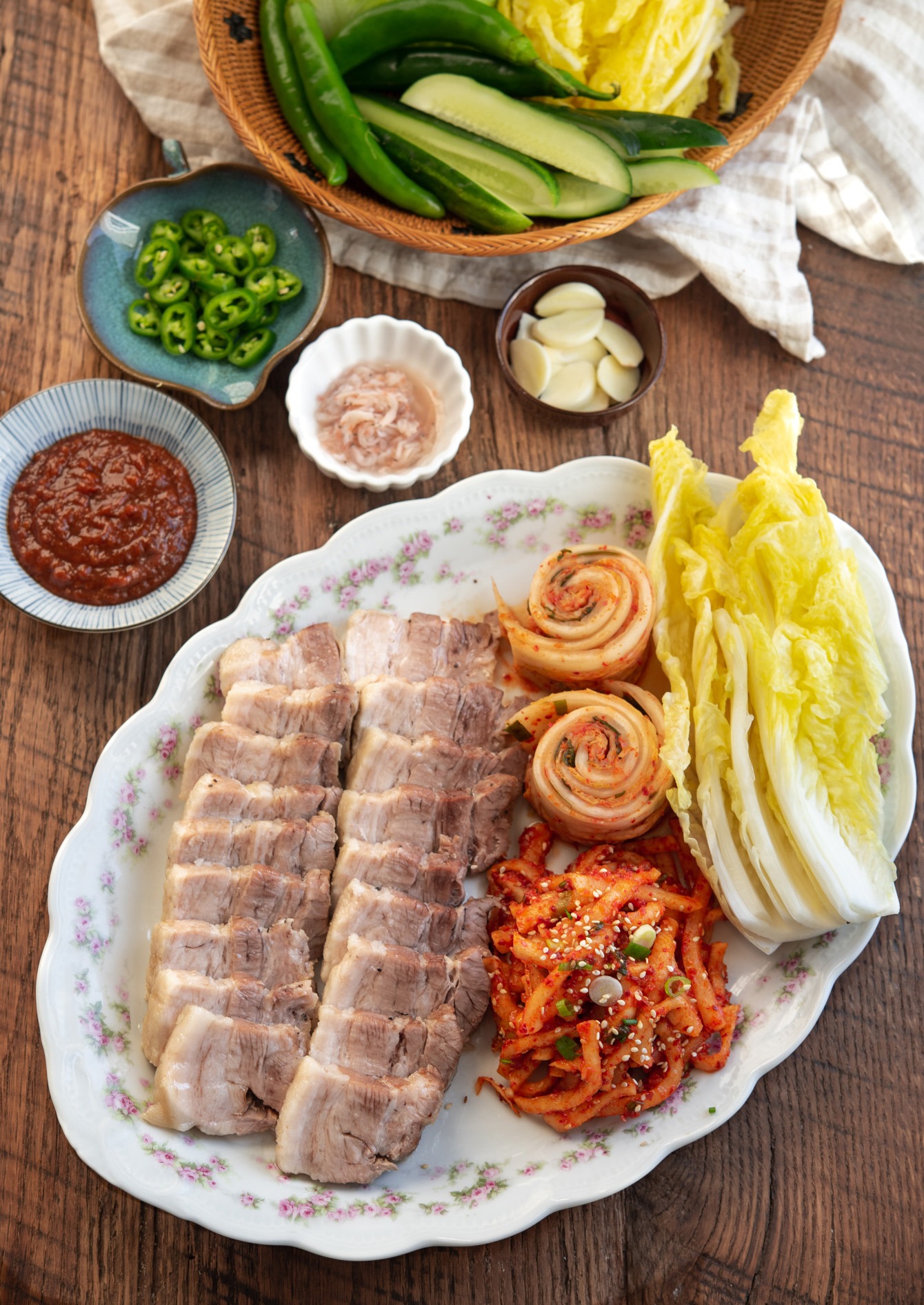
If you are hosting a dinner party, this Korean pork belly recipe will definitely be delicious and memorable for your guests. Have a bossam party!
This iconic Korean dish is made from boiled pork, garlic, radishes, onions, and other seasonings, then wrapped in a huge cabbage and perilla leaf. You will love the taste and texture, and most of all, it’s fun dining together making bossam wraps with varying ingredients.
What is Bossam?
Bossam is a popular Korean dish, consisting of boiled pork belly wrapped with napa cabbage leaves or lettuce, and served with dipping sauce called Ssamjang (쌈장, or Ssam sauce).
Traditionally a thick cut of pork belly is boiled in a slightly flavored broth until tender and moist. Then each person makes a wrap with a cabbage leaf, a slice of the cooked pork and a variety of side dishes – such as spicy radish salad, raw garlic, salted shrimp (saeu-jeot), fresh chili, and wrap sauce (ssamjang).
Korean Bossam tradition: Every year in the late fall, Koreans make a huge batch of cabbage kimchi to last through the cold winter months. This kimchi making activity is usually done with extended family members or neighbors. When the kimchi making is just finished people gather around and enjoy bossam with salted cabbage leaves or freshly made kimchi.
It is an iconic cultural dish that every Korean shares with one another. Treating any helpers with bossam is a sign of gratitude for their support.
Oven roasted pork belly is another adaptation of this recipe. Also check out my cookbook, Korean cooking favorites, for more pork recipes.
What does bossam taste like?
The pork itself is mild and juicy. But the bossam sauce made with Korean soybean paste (doenjang) and toppings you add in the wrap makes the overall flavor. It’s like having a juicy mild pork with a robust flavor kick mingled together in the mouth.
Plus the crisp tender pickled cabbage and fresh lettuce adds pleasant texture and bites. It can be a little spicy but the spicy level is adjustable.
Choosing pork belly
Pork belly is the most commonly used pork cut for bossam, but pork shoulder (pork butt) is another good choice. You might find two pork belly options: with skin on or without.
Either one works fine for boiled Korean pork belly recipe but I prefer the one without the skin (although it tends to be more costly) to enjoy the soft and tender texture of bossam. Try my pork belly rice bowl (butadon) recipe for a skin-on pork belly dish.
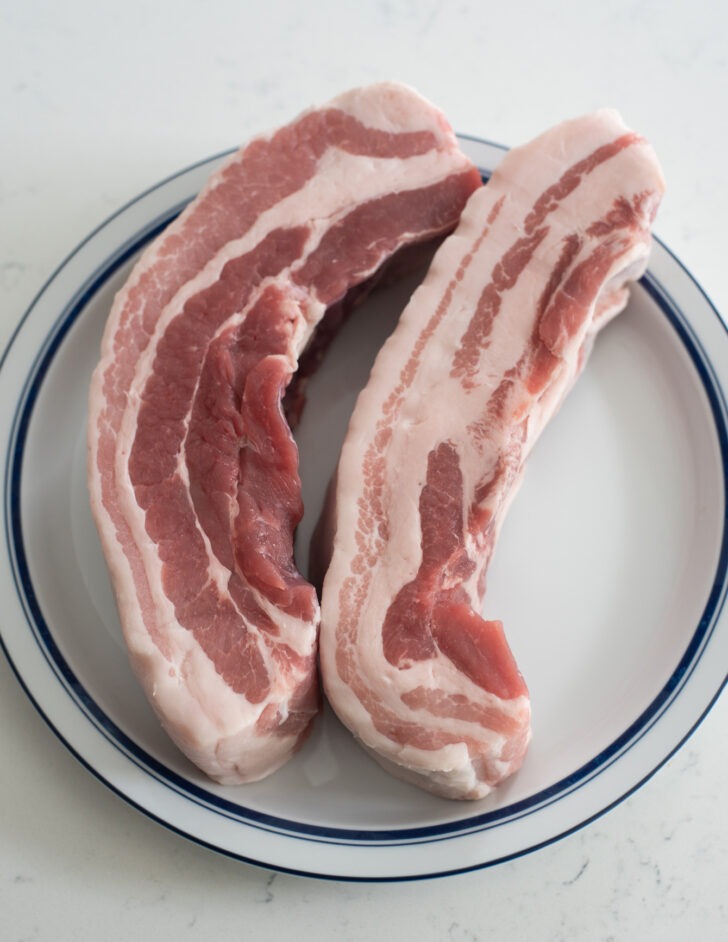
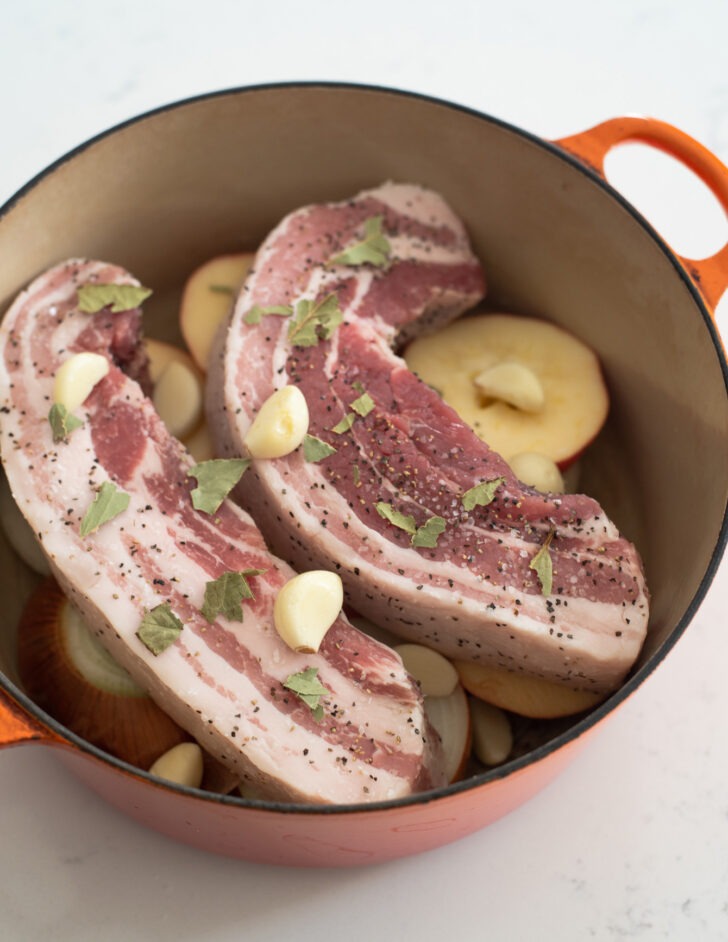
The best way to cook pork belly
Most cooks boil their pork belly for bossam recipe in a broth seasoned with Korean soybean paste (doenjang). Some add coffee or other spices mainly to get rid of any gamey smell.
However, I found it unnecessary. You will lose a lot of natural flavor of the pork if you simmer it in water too long. Simmering a piece of meat in water is good for making soups and stews for which you enjoy the broth you cooked the meat in. We don’t consume the broth after cooking bossam.
I suggest trying a low moisture (minimum moisture) cooking method for bossam. Your pork will cook in its own juice along with vegetables and fruits, which creates sufficient moisture inside the pot while simmering.
The only liquid you add is sweet rice wine (mirim). Other than that, you don’t need any liquid to cook the pork. You will have tender, juicy, and succulent pork meat, guaranteed. And there’s no gamey smell at all!
Ever since I learned the low moisture cooking method for pork belly, I can’t go back to the old-fashioned boiling method to prepare bossam. It’s much simpler, too, with the similar preparation time.
The only drawback is that you will need a heavy bottom pot with a tight lid, such as a dutch oven, in order to obtain the best result. Any heavy bottom pot will do a great job.
How to eat Bossam
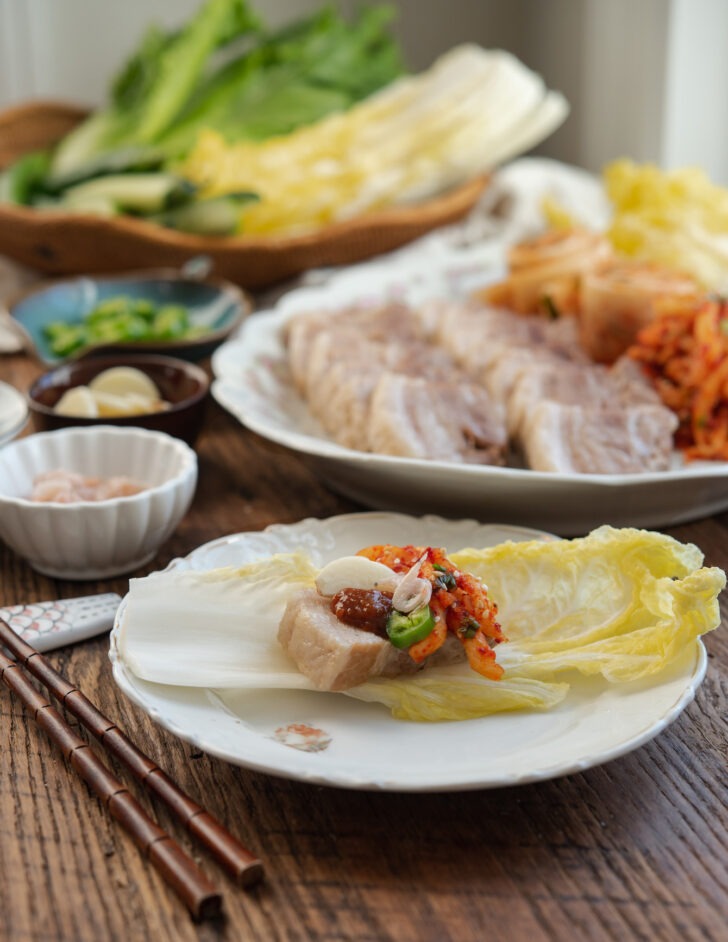
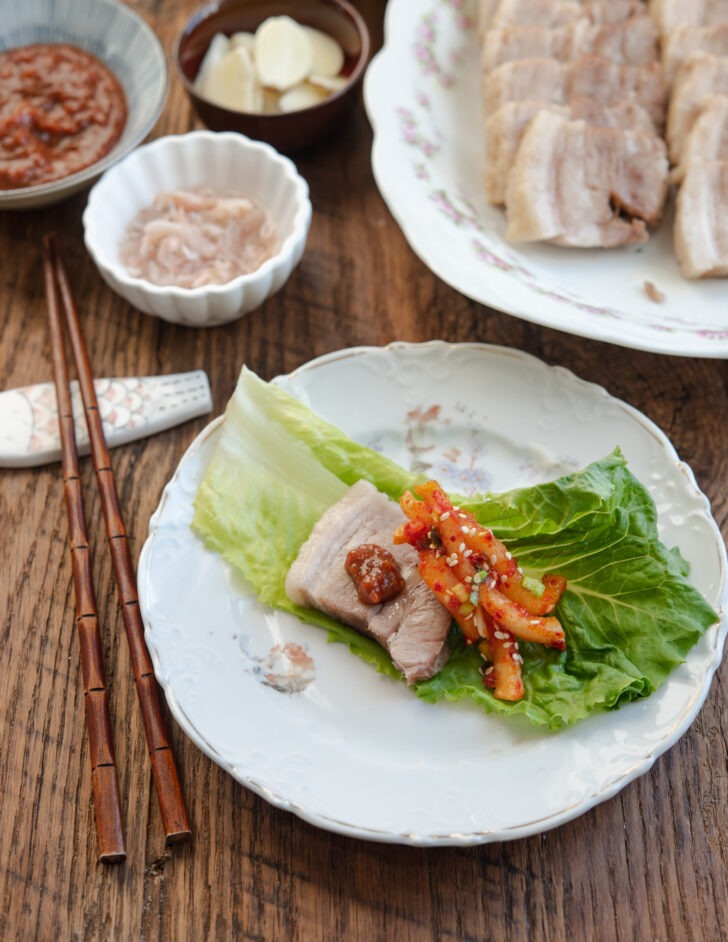
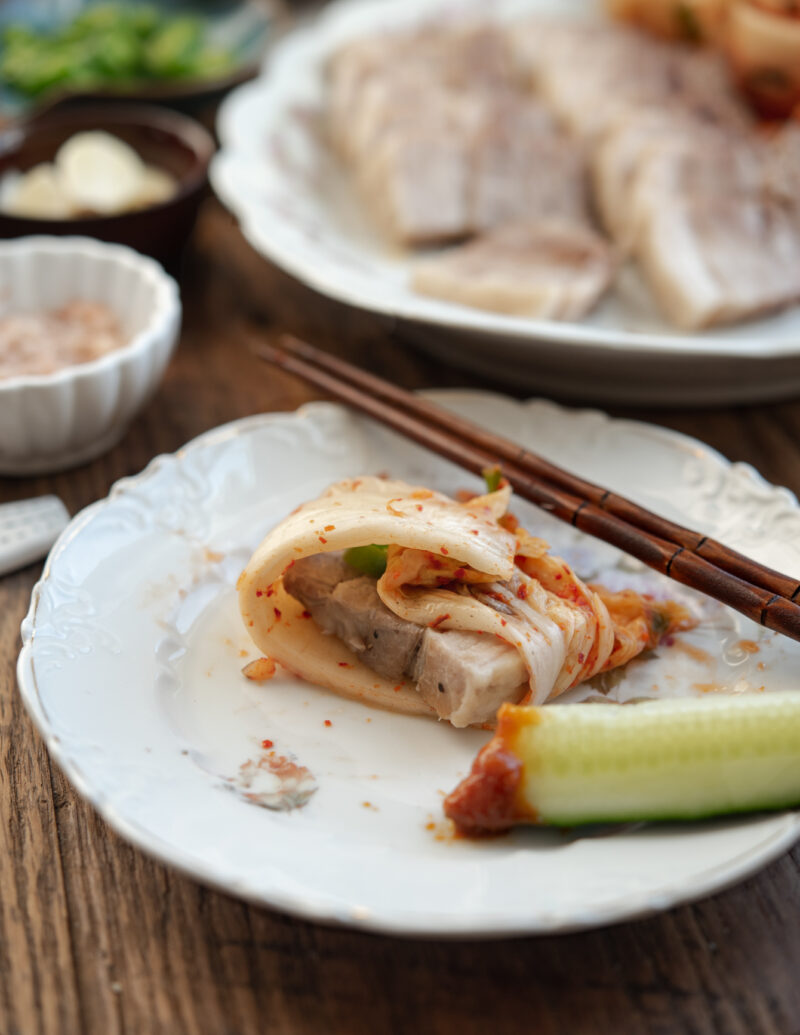
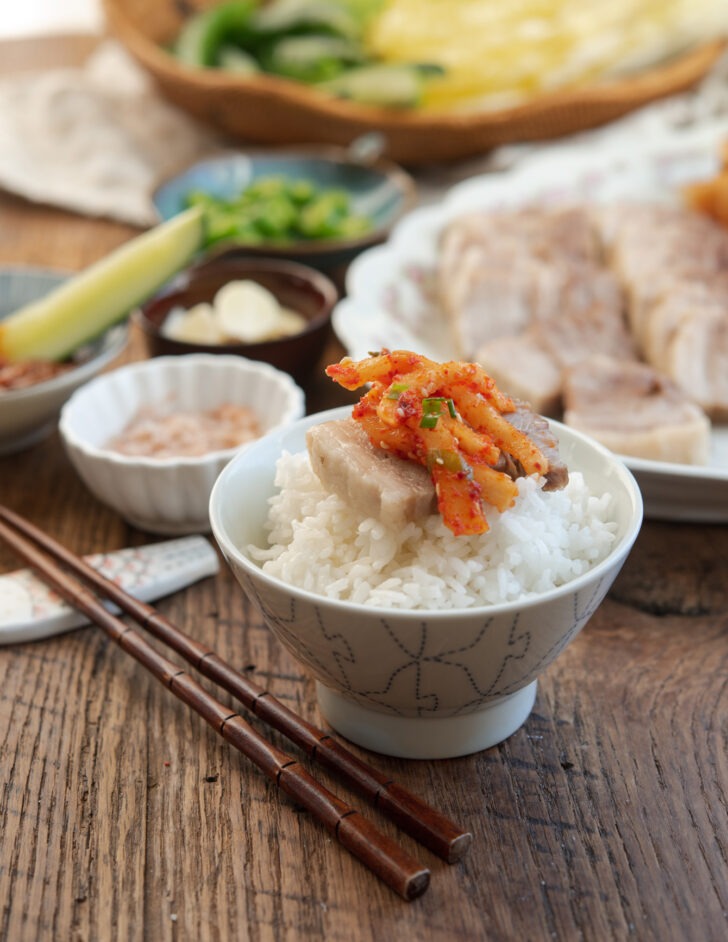
The word “bossam (보쌈)” means bundling. Basically, you will bundle up the meat as a wrap using napa cabbage leaves, lettuce, perilla leaves (kkennip), or freshly made cabbage kimchi as a vessel. And don’t forget the homemade ssamjang topping sauce.
A bossam wrap can be quite big to put inside your mouth all at once. You can bite off a chunk if you prefer. But Koreans put the whole thing in all at once. If you don’t want to make a wrap at all, just enjoy the pork belly and spicy radish salad together, or serve it with rice.
Use lots of toppings to make the delicious bossam wraps. Below options are what goes with bossam.
- spicy radish salad – recipe follows
- green onion salad (pa-muchim)
- salted shrimp – use store-bought
- cabbage – either fresh or salted napa cabbage leaves (instruction follows)
- cabbage kimchi – freshly made (Try my easy cabbage kimchi or traditional whole cabbage kimchi)
- fresh oysters – optional
- assorted lettuce
- perilla leaves (kkennip)
- raw garlic cloves – sliced
- fresh chili – sliced
- ssam sauce (ssamjang) – one of the common Korean pantry staples. Homemade recipe follows
Another great side dish to serve with bossam will be minari salad. Minari is Korean water dropwort (water parsley). If you can get hold of this detoxifying vegetable, get it and make the minari salad. It is so good together with this Korean boiled pork.
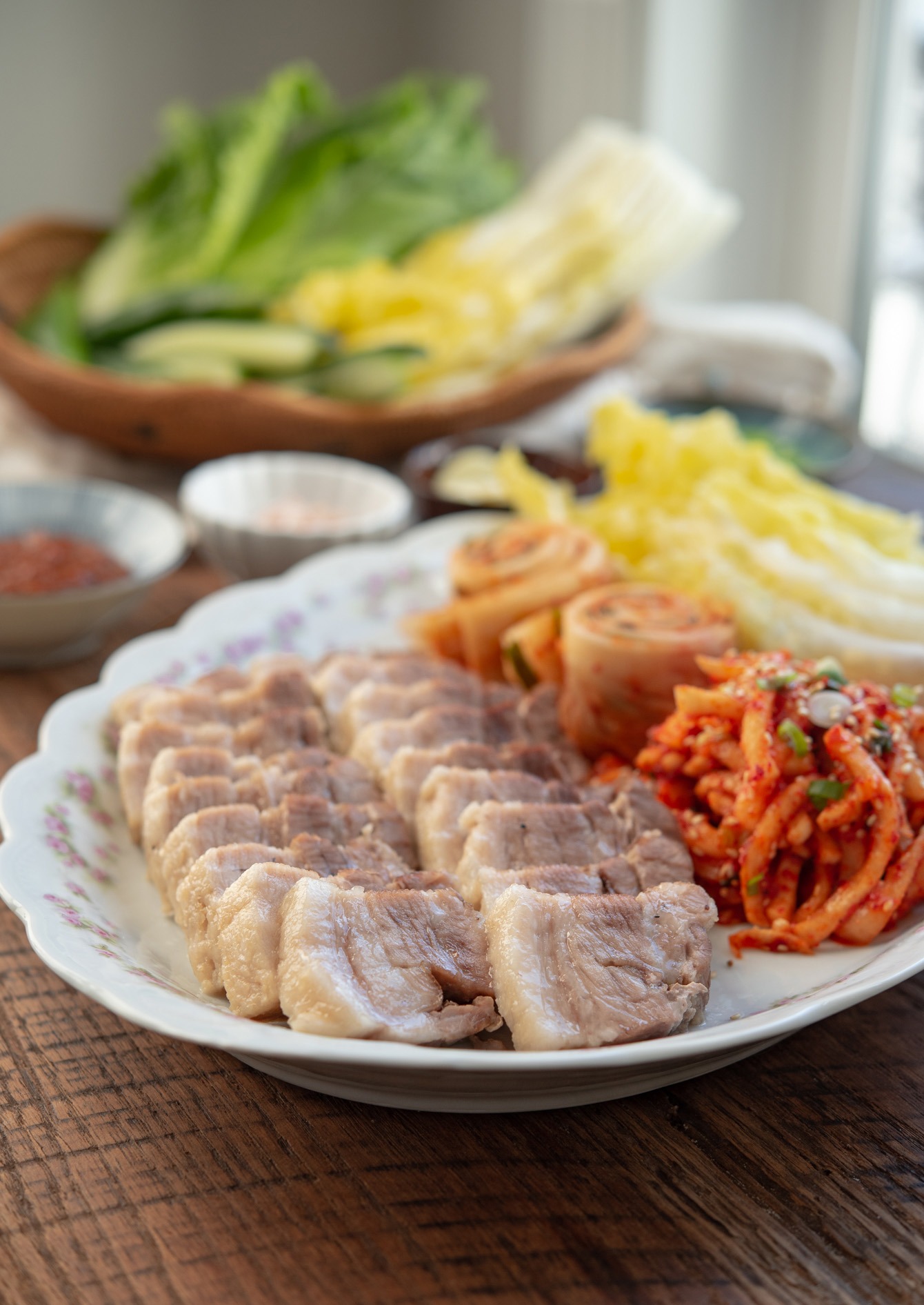
How to make Bossam (Korean Pork Belly Wraps)
Pickling the cabbage
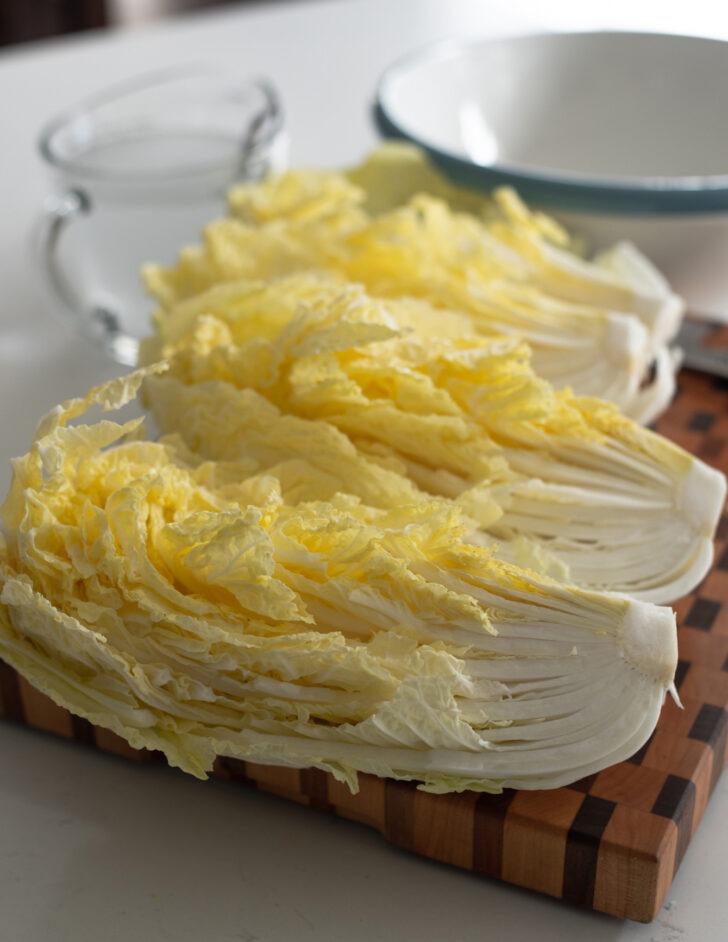
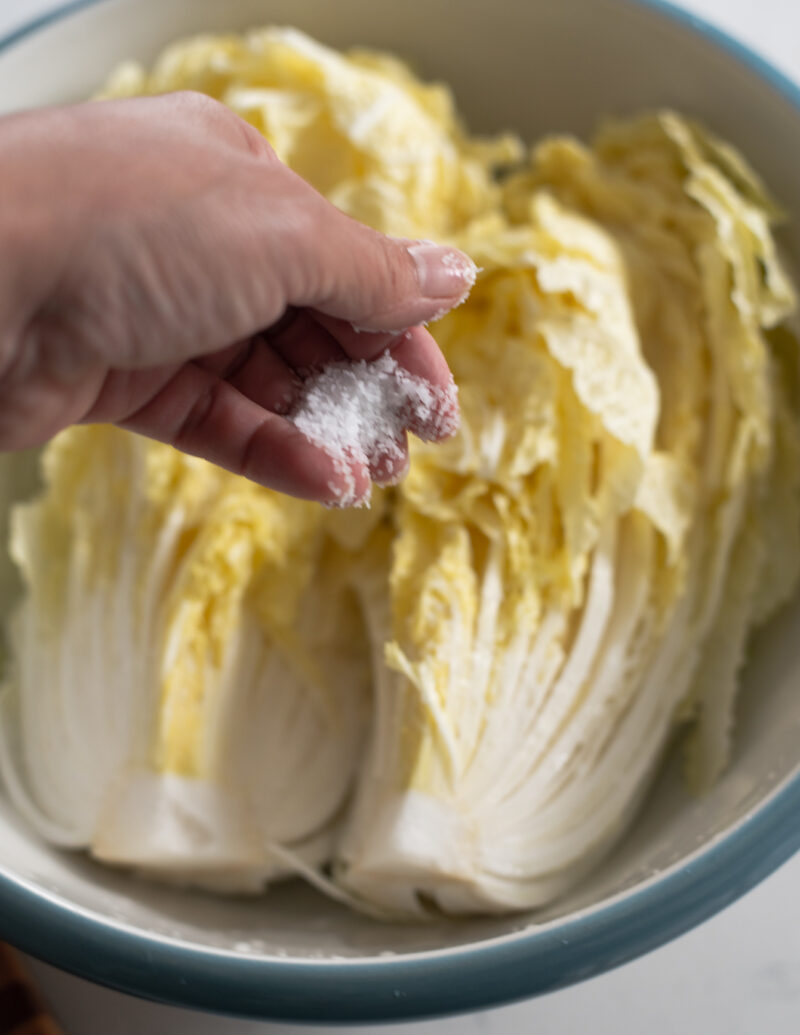
Use the yellow inner part of napa cabbage.
- Quarter the cabbage lengthwise. Depending on the size of your cabbage, you might only need 2 of them. Rinse the cabbage pieces with water and drain.
- In a large shallow mixing bowl, place the cabbage pieces and sprinkle salt over the cabbage trying to reach in between the layers of leaves, especially the thick white stem parts. Let the cabbage sit for 50 minutes, turning them upside down 2-3 times. Rinse the cabbage once and squeeze out the extra moisture.
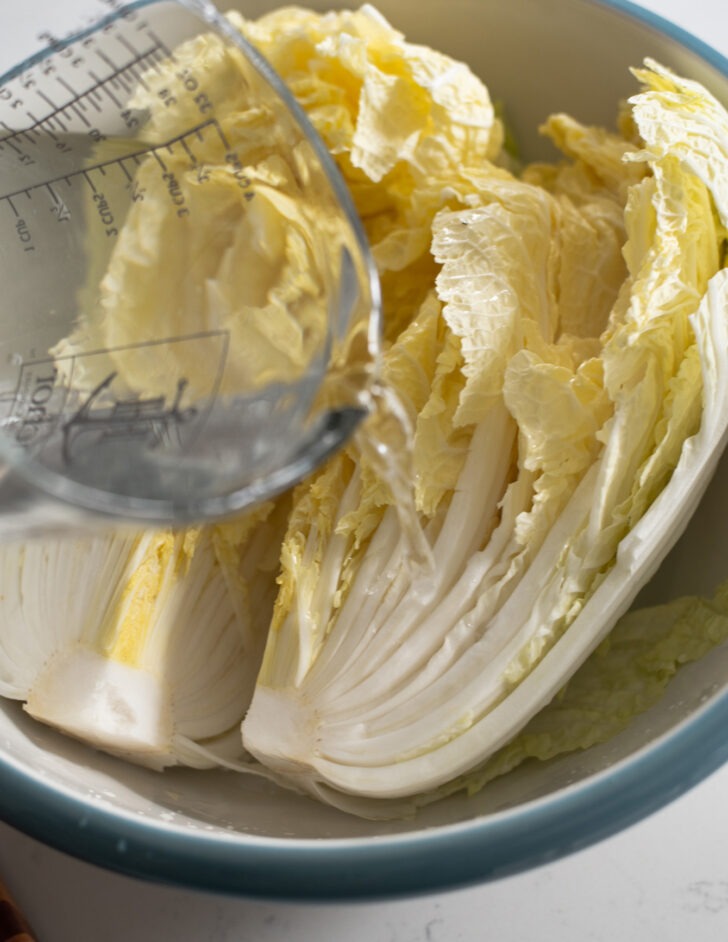
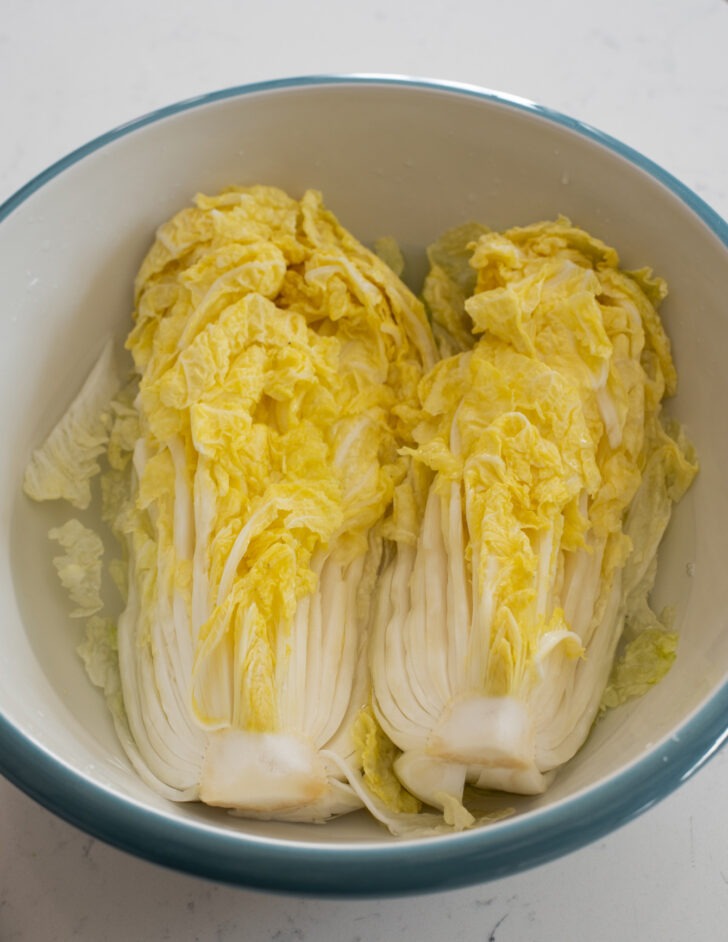
Another option for cabbage pickling:
- If you want to prepare the cabbage well ahead of time, use a salt brine instead. Dissolve 1/2 cup salt in 6 cups of water.
- Soak the cabbage in the salt brine overnight until slightly wilted. Rinse and squeeze out the extra moisture. Keep the cabbage in a zip bag and chill until ready to use.
Cook pork belly –low moisture cooking method
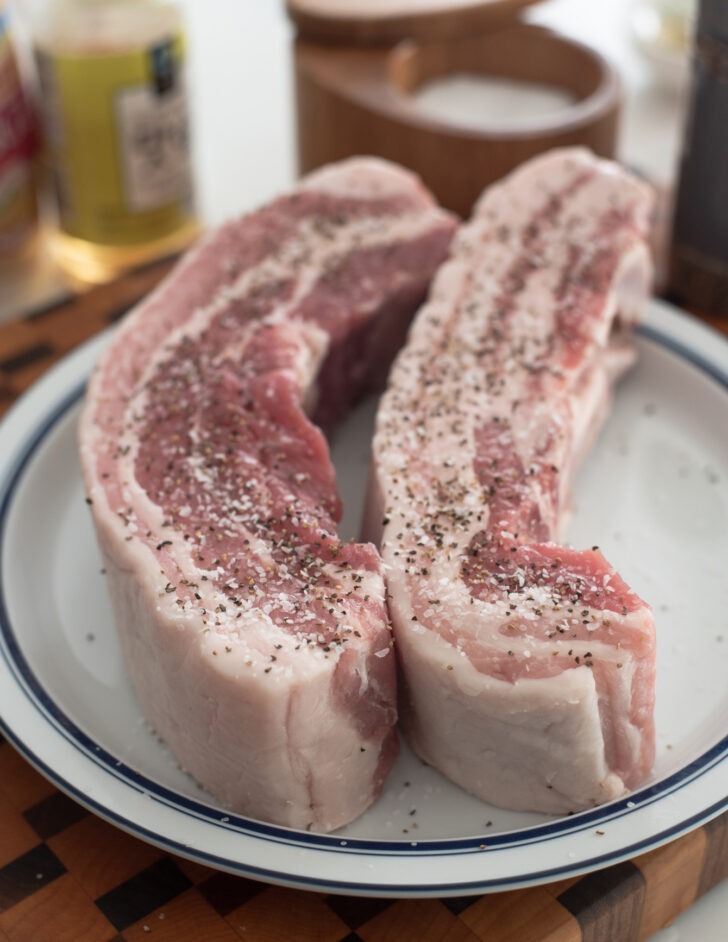
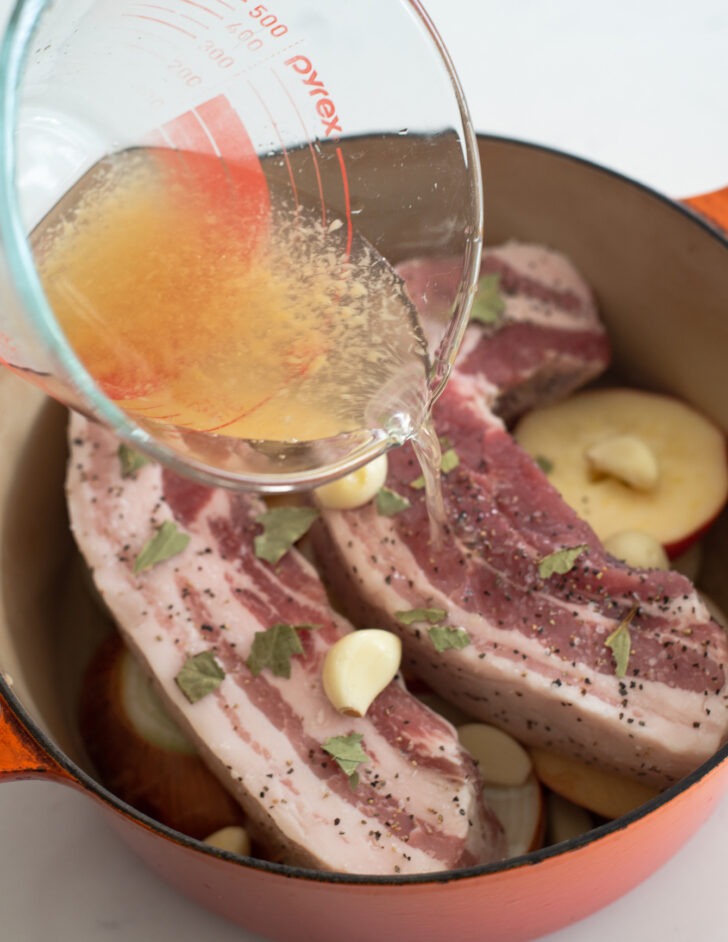
While cabbage is being salted, prepare the pork belly.
- In a large, heavy bottom pot, put in diced onion followed by sliced apples. Season pork belly with salt and pepper and place it on top. Add the garlic and crumbled bay leaves.
- In a small mixing bowl, mix together sweet rice wine and ginger puree, and drizzle it around the pork belly. Top the pork belly with sliced leek (or green onion).
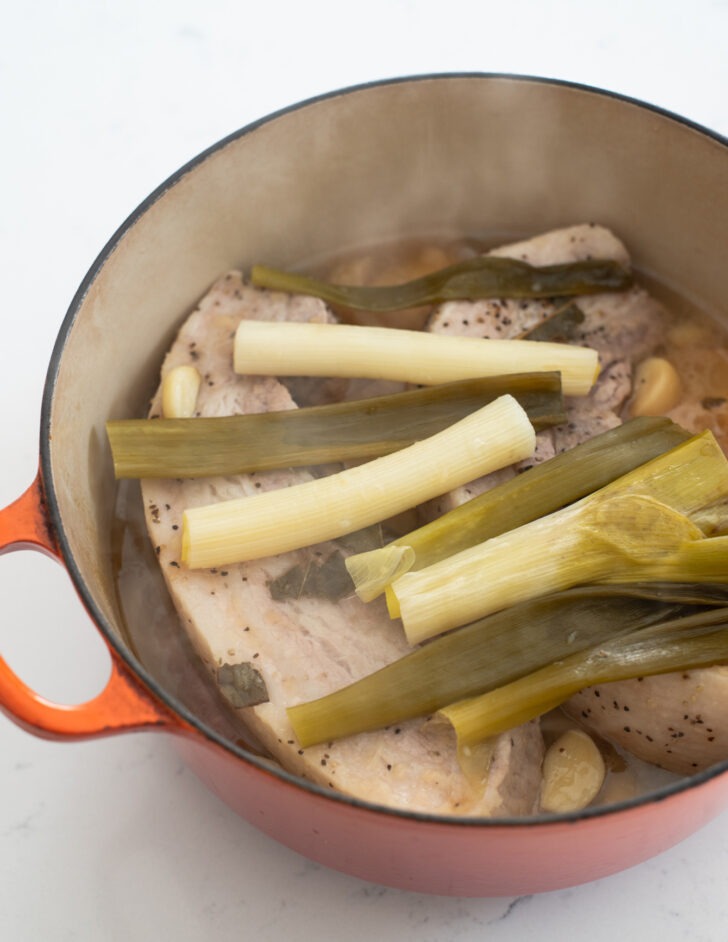
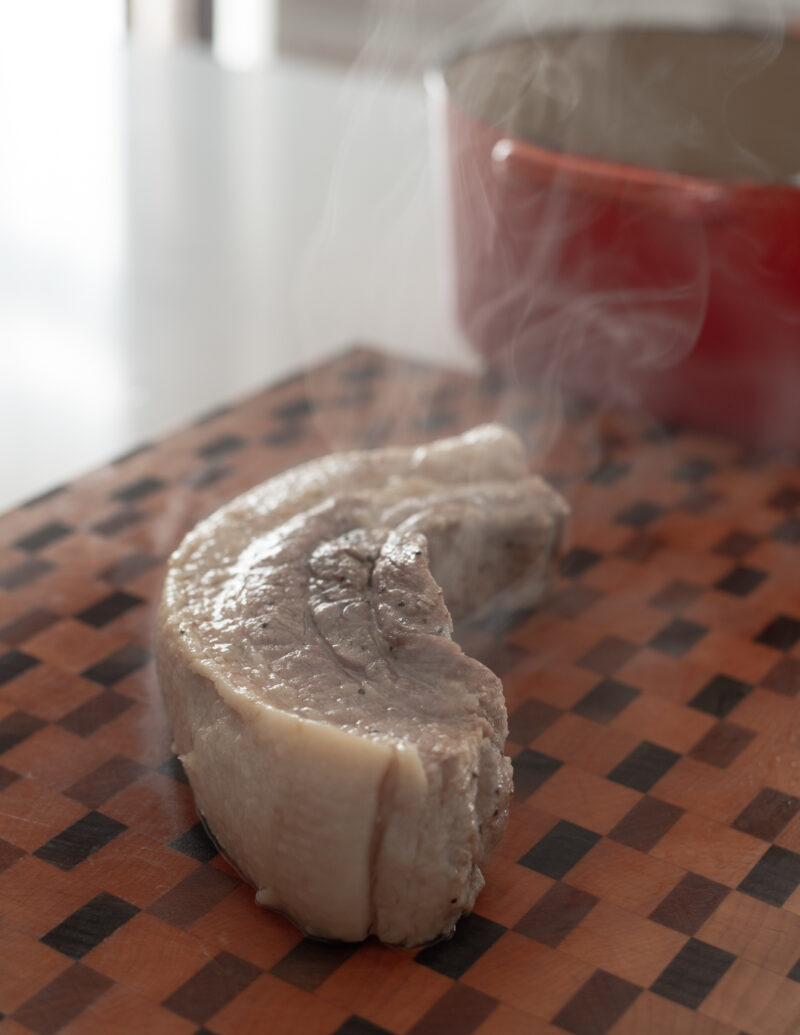
- Cover with lid and let it cook over medium high heat for 5 minutes. Reduce the heat to low and simmer for 40-50 minutes depending on the thickness of your meat.
- Let the pork rest in the pot for 10 minutes, then slice it.
Make spicy radish salad
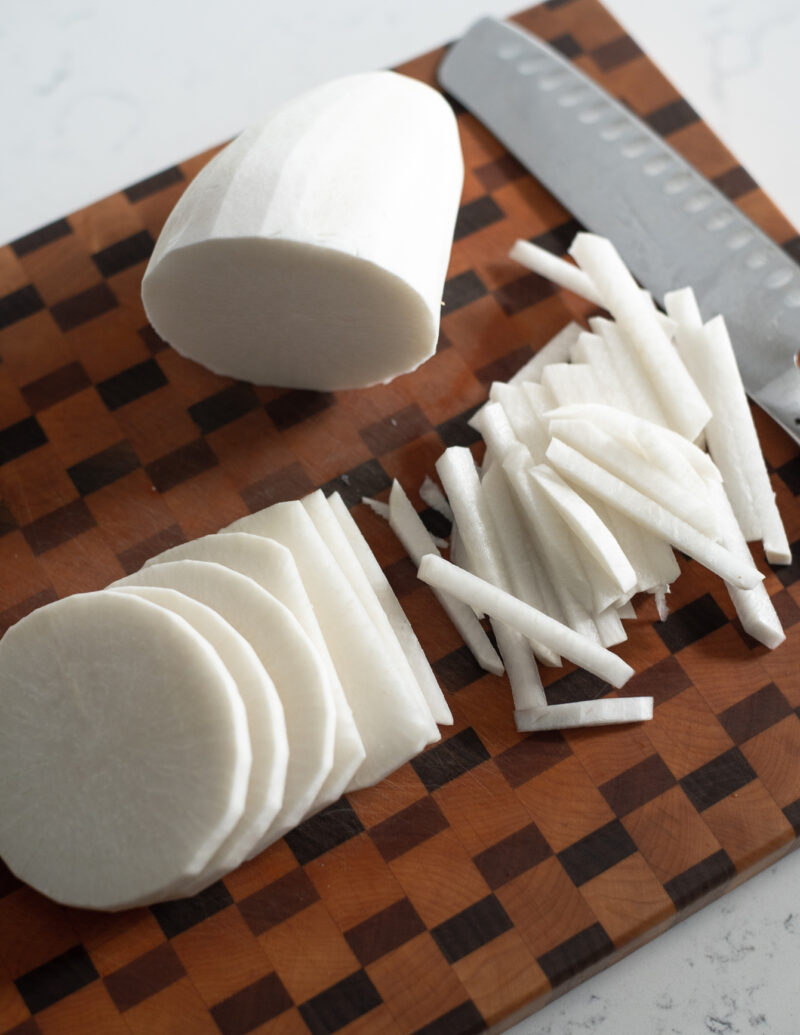
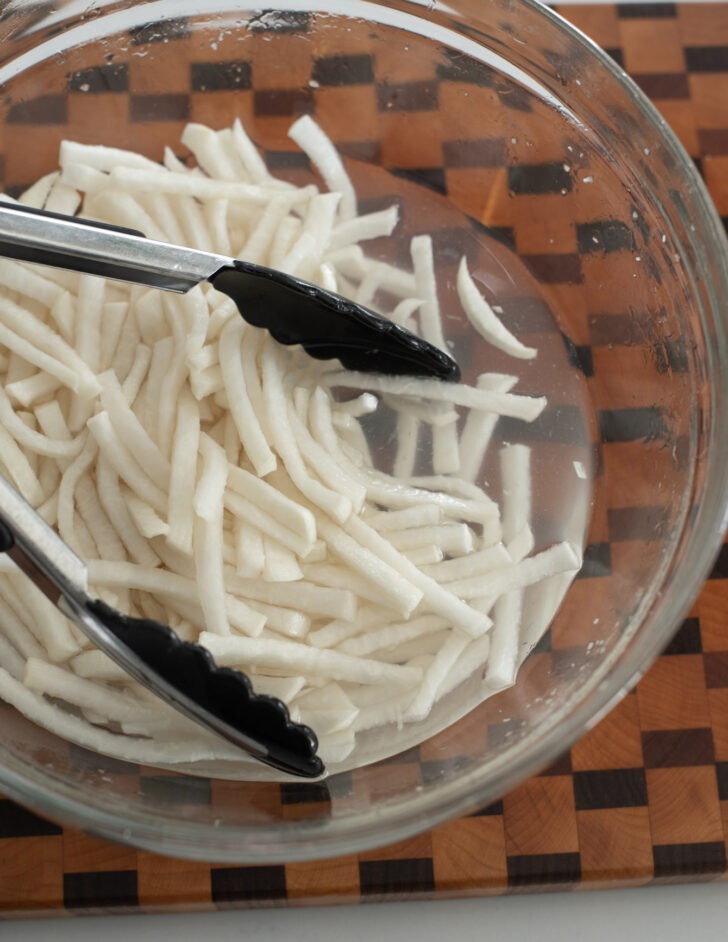
Make this radish salad while pork is simmering.
- Peel and slice radish into 1/4-inch thick matchsticks. Place them in a mixing bowl.
- Add corn syrup and 1 tablespoon of salt. Toss well and let it sit for 30-45 minutes. You will see lots of moisture come out from the radish.
Recipe Tip: Corn syrup withdraws the moisture from the radish like no other and it maintains the crunchy texture. The radish sticks will hold their shape and won’t leak much moisture after they are seasoned. The salad will keep its freshness in the refrigerator up to 2 weeks.
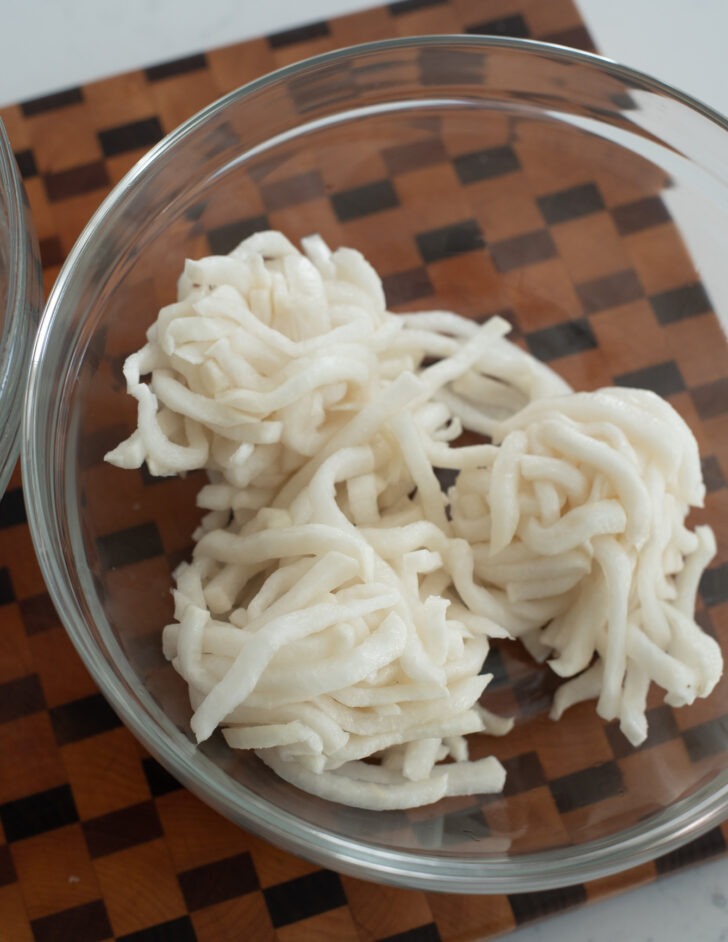
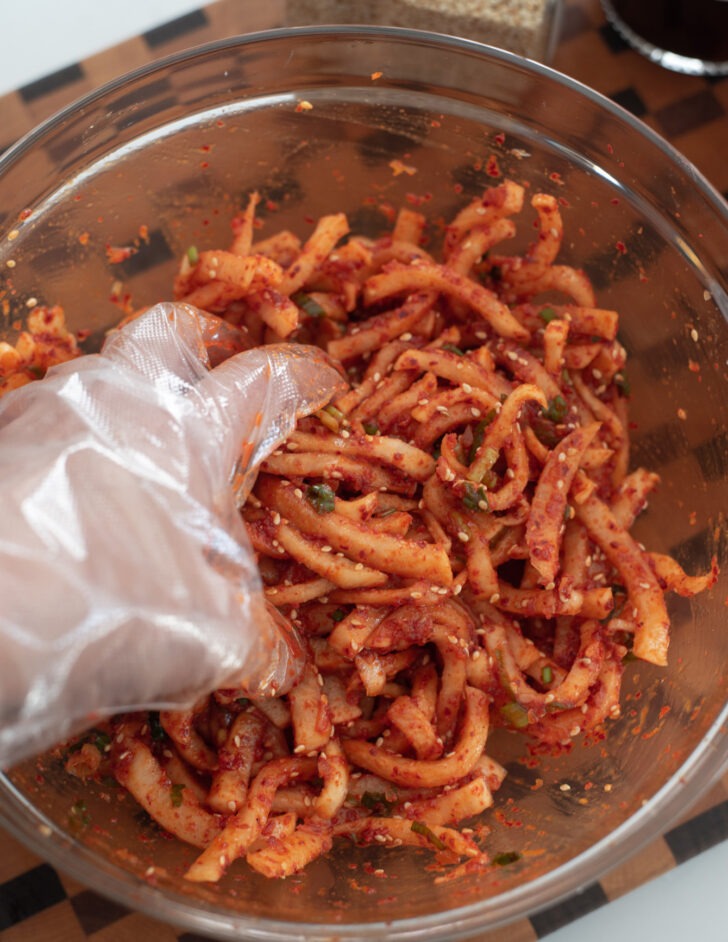
- Squeeze out the moisture firmly and put the radish in to another mixing bowl.
- Add the Korean chili flakes, Korean fish sauce, salted shrimp, sugar, garlic, Korean plum extract (optional), ginger puree, sesame seeds, and green onion. Mix well and chill in the refrigerator until ready to serve.
Ssamjang sauce
You must have the topping sauce called ssamjang for any bossam dish. Store-bought ssam sauce can be convenient, but homemade ssamjang is very easy and quick to make.
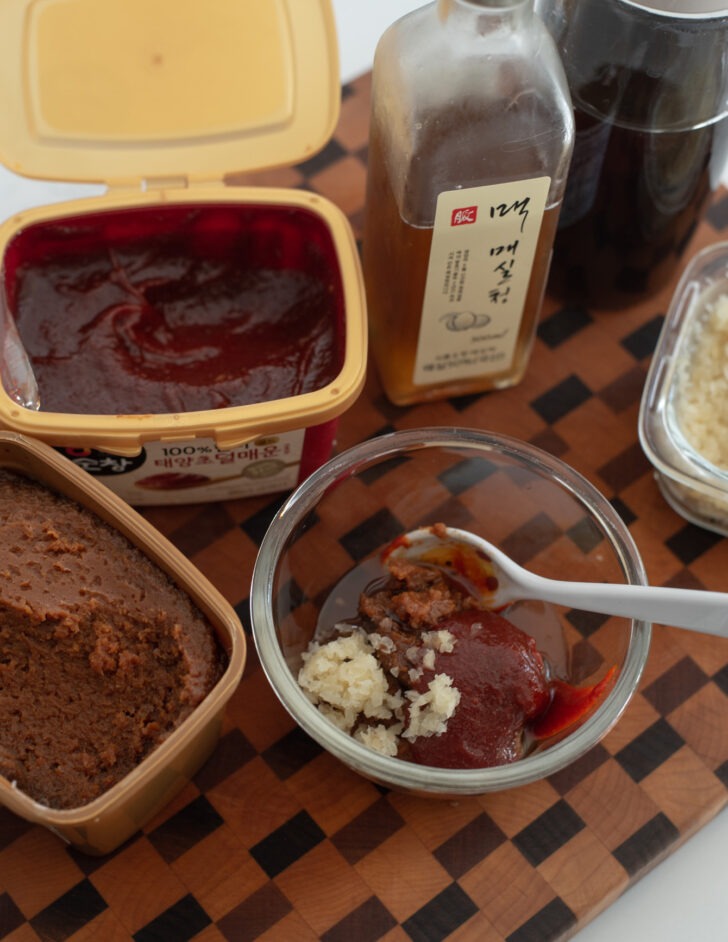
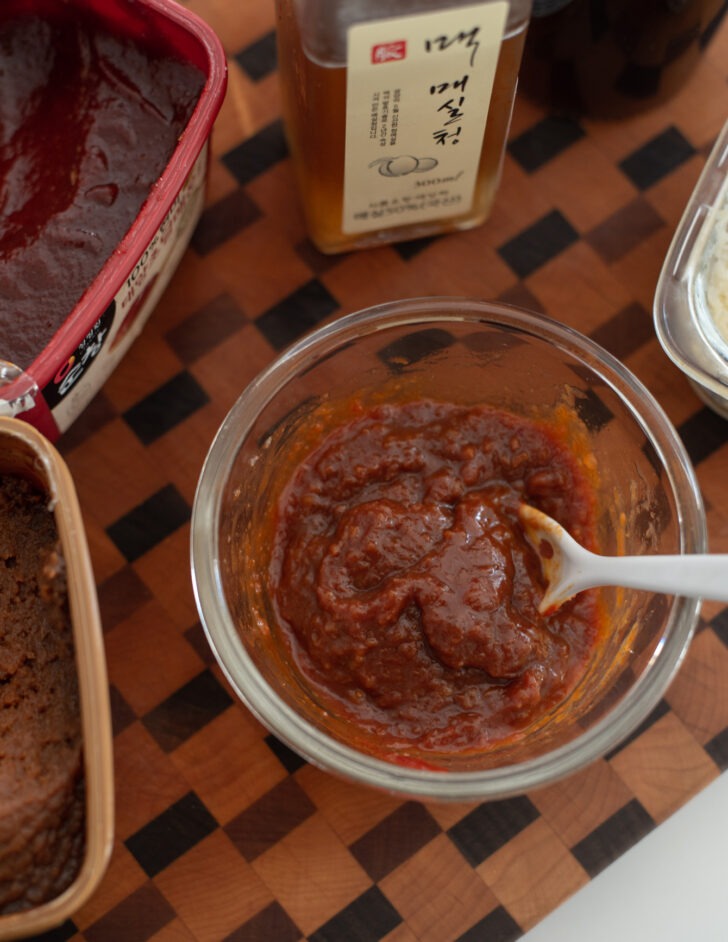
- In a small bowl, combine Korean soybean paste, Korean chili paste, garlic, Korean plum extract (optional), and sesame oil. Mix well and chill until ready to serve.
Arrange bossam platter with toppings
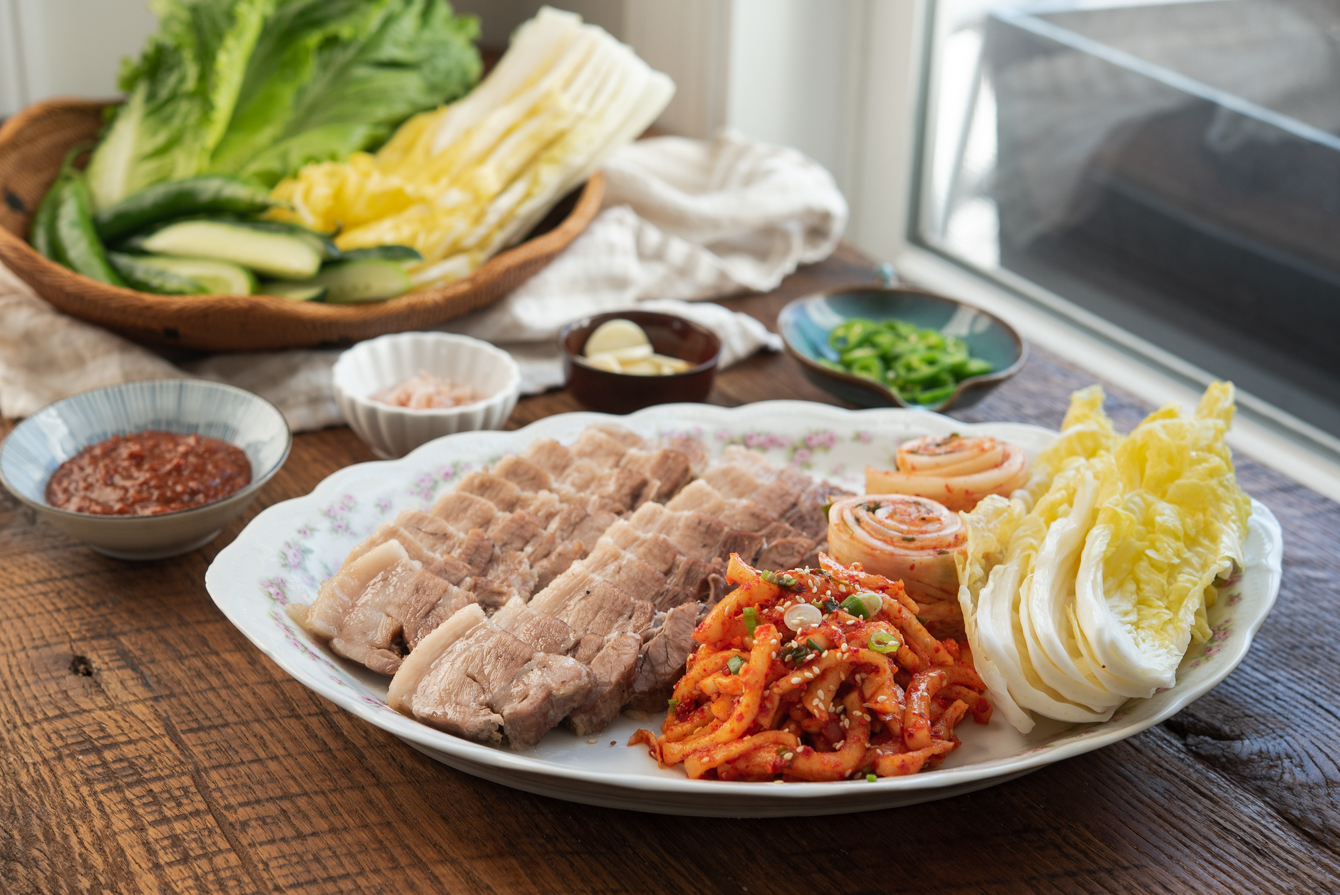
Step 5: Arrange with side dishes and toppings, and serve
- Put pork belly slices on a large serving platter and arrange the spicy radish salad, salted cabbage, and other wrap materials around it.
- Serve with salted shrimp, raw garlic slices, and chili slices in small containers near the platter.
- To make a wrap, place a piece of pork belly on a cabbage leaf, lettuce or perilla leaf. Dot with bossam sauce (ssamjang), and top with a tiny bit of salted shrimp, raw garlic, green chili, and serve. You can also use a piece of cabbage kimchi to wrap a pork.
More Pork Recipes
If you are a pork lover, here are a few of pork recipes that you might like.
- Samgyupsal (Korean BBQ Pork Belly)
- Spicy Korean Pork Bulgogi (Jeyuk Bokkeum)
- Crispy Tonkatsu (Japanese Pork Cutlet)
- Korean Meat Tofu Patties (Wanja-jeon)
- Twice Cooked Pork (Sichuan Pork Stir-Fry)
Love this recipe? Rate it and share your experience in the comments below! On Instagram? Tag me to showcase your creation. For more delicious recipes, subscribe to our newsletter!

Best Bossam Recipe (Korean Pork Belly Wraps)
Ingredients
For bossam wraps
- bunch assorted lettuce
- bunch perilla leaves (kkennip), optional
- cabbage kimchi, freshly made kimchi preferred
- bunch fresh oysters, optional
- 2 tbsp salted shrimp
- 5-7 cloves fresh garlic , sliced
- 1-2 fresh green chilies, sliced
For pickling cabbage
- 1 head (about 2 lb, 900 g)) small napa cabbage, quartered
- 4 tbsp kosher salt, see note below
For pork belly
- 2 1/2 lb (1.2 kg) thick pork belly, preferably skin removed
- pinches salt and pepper , to season
- 2 onion, roughly sliced
- 1 apple, roughly sliced
- 10 cloves garlic
- 2 bay leaves, crumbled
- 1/2 cup (120 ml) sweet rice wine (mirim)
- 1 tbsp ginger paste
- 1 Asian leek, optional, roughly sliced
For radish salad
- 1 1/4 lb (560 g) Korean radish or daikon radish, peeled
- 1/2 cup (120 ml) Korean corn syrup (mulyeot)
- 2 tsp salt
- 2-3 tbsp Korean chili flakes (gochugaru)
- 1 tbsp Korean fish sauce
- 1/2 tbsp salted shrimp
- 1 tbsp minced garlic
- 1/2 tbsp sugar
- 1 tbsp Korean plum extract (maeshil-cheong), optional
- 1 tsp ginger paste
- 2 green onion, fienly chopped
For topping sauce
- 3 tbsp Korean soybean paste (doenjang)
- 1 tbsp Korean chili paste (gochujang)
- 2 tsp minced garlic
- 1 tbsp Korean plum extract (maeshil-cheong), or water
- 2 tsp sesame oil
Equipment
Instructions
To pickle the cabbage
- Use the yellow inner part of napa cabbage. Quarter the cabbage lengthwise. Depending on the size of your cabbage, you might only need 2 of them. Rinse the cabbage with water and drain.
- In a large shallow mixing bowl, place the cabbage pieces and sprinkle salt over the cabbage trying to reach in between the layers of leaves, especially the thick white stem parts. Let the cabbage sit for 50 minutes, turning them upside down 2-3 times. Rinse the cabbage once and squeeze out the extra moisture.
To cook pork belly
- In a large, heavy bottom pot, put in diced onion followed by sliced apples. Season pork belly with salt and pepper and place it on top. Add the garlic and crumbled bay leaves.
- In a small mixing bowl, mix together sweet rice wine and ginger puree, and drizzle it around the pork belly. Top the pork belly with sliced leek (or green onion).
- Cover with lid and let it cook over medium high heat for 5 minutes. Reduce the heat to low and simmer for 40-50 minutes depending on the thickness of your meat.
- Let the pork rest in the pot for 10 minutes, then slice it.
To make spicy radish salad
- Slice radish into 1/4-inch thick matchsticks. Place them in a mixing bowl.
- Add corn syrup and 1 tablespoon of salt. Toss well and let it sit for 30-45 minutes. You will see lots of moisture come out from the radish. Squeeze out the moisture firmly and put the radish in to another mixing bowl.
- Add the Korean chili flakes, Korean fish sauce, salted shrimp, sugar, garlic, Korean plum extract (optional), ginger puree, sesame seeds, and green onion. Mix well and chill in the refrigerator until ready to serve.
To make bossam sauce
- In a small bowl, combine Korean soybean paste, Korean chili paste, garlic, Korean plum extract (optional), and sesame oil. Mix well and chill until ready to serve.
To serve bossam
- Put pork belly slices on a large serving platter and arrange the spicy radish salad, salted cabbage, and other wrap materials around it.
- To make a wrap, place a piece of pork belly on a cabbage leaf, lettuce or perilla leaf. Dot with bossam sauce, and top with a tiny bit of salted shrimp, raw garlic, green chili, and serve. You can also use a piece of cabbage kimchi to wrap a pork.
Notes
- If you want to prepare the cabbage well ahead of time, use a salt brine instead. Dissolve 1/2 cup salt in 6 cups of water.
- Soak the cabbage in the salt brine overnight until slightly wilted. Rinse and squeeze out the extra moisture. Keep the cabbage in a zip bag and chill until ready to use.
This recipe was originally posted in November 2016. I’ve updated the recipe with minor changes, new photos, and more information.


This is my kind of wrap! Looks incredibly delicious!
Hi..unfortunately I’m currently unable to eat / drink any food with any alcohol content. Is it possible to omit / remove the white wine? Or is there any other substitute for the w.wine?
Thanks!
As my son needs a gluten-free diet the available doenjang around here is a no go for me. I managed to make my own gluten-free gochujang, but making doenjang is a longer process (though I’m willing to try it out soon).
So, my question is, would it be possible to substitute doenjang with gluten-free miso to cook this recipe?
Yes, definitely!
Wonderful match!!!! Pork belly is so good with kimchi.
Pork belly is good stuff. Don’t eat it that often (all that fat, you know) but love it whenever I do. Thanks!